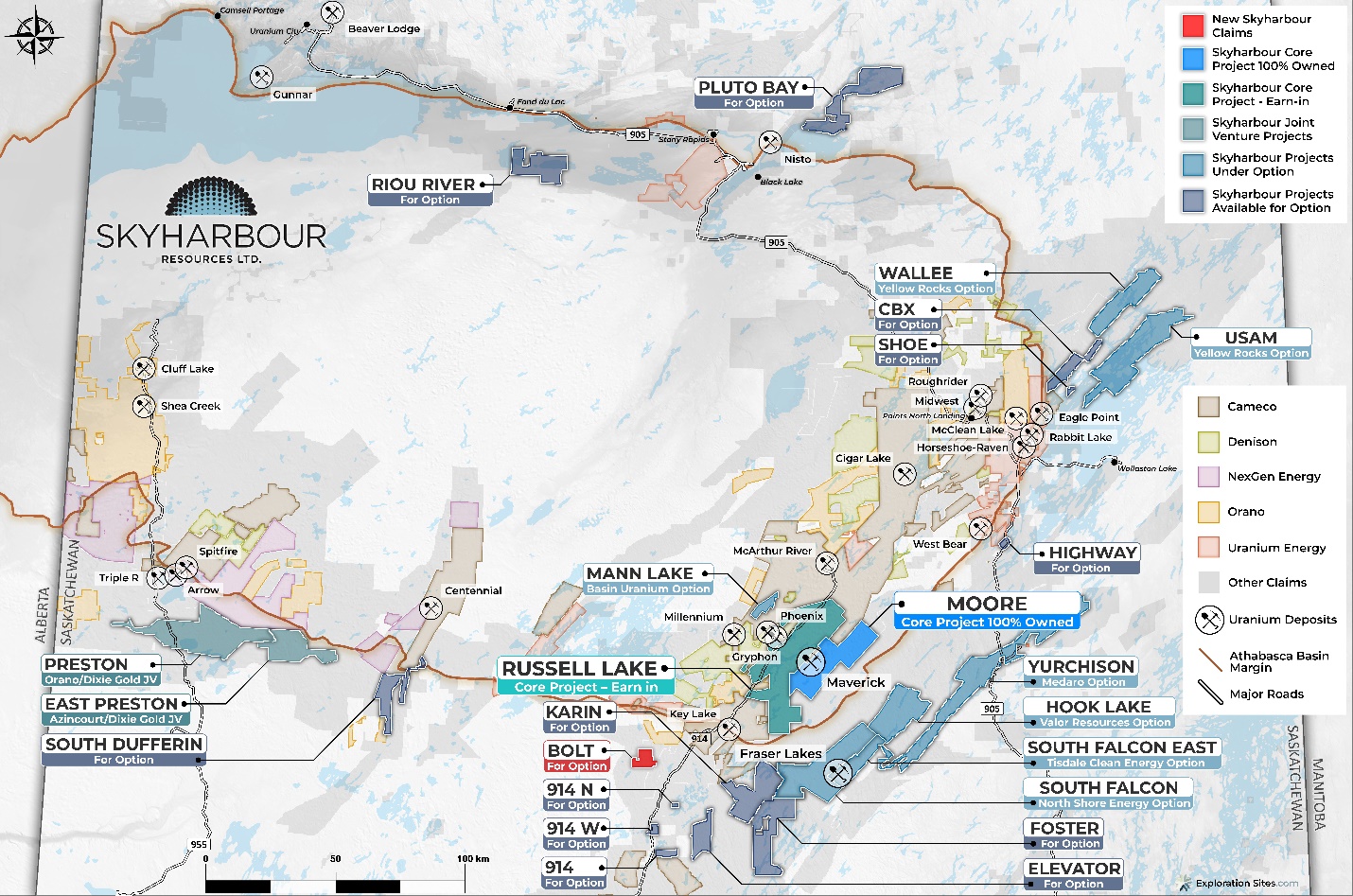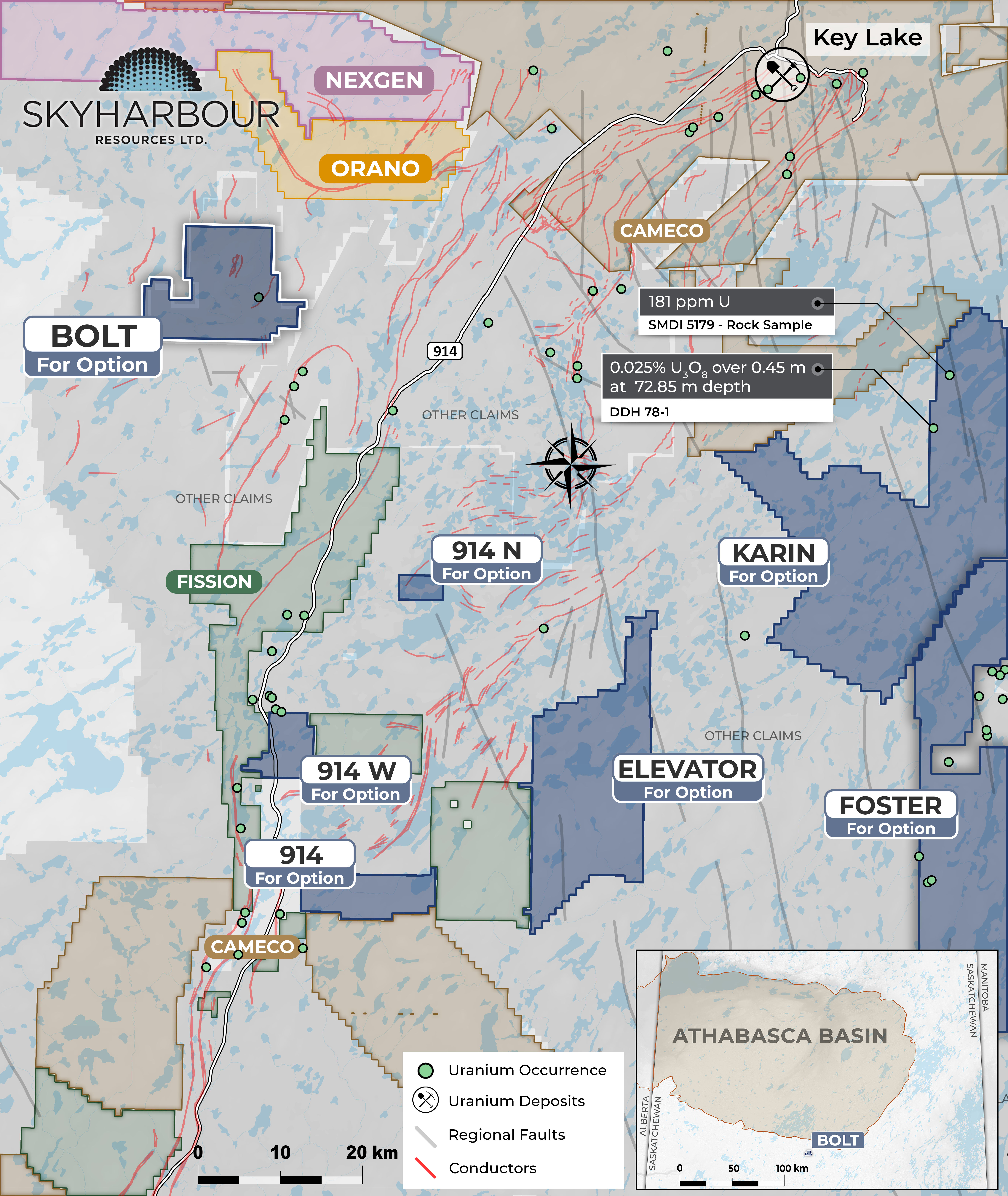Bolt Project
The Bolt Project consists of 2 contiguous claims 100% owned by Skyharbour Resources Ltd. totalling 4726.35 hectares and is located approximately 7 km west of the Highway 914 and about 32 km southwest of Cameco’s Key Lake Operation (which produced 209.8 million pounds of U3O8 at an average grade of 2.32% U3O8 from 2 deposits, where ore from the McArthur River mine is currently processed).
The Bolt Project lies approximately 15 km from the southern rim of the Athabasca Basin, and is within the Eastern Mudjatik Domain of the Hearne Craton. Geological mapping conducted by the Saskatchewan Geological Survey in the 1970’s and 1980’s of the area determined the project is predominantly underlain by a south-trending, anastomosing package of amphibole gneisses, surrounded by regional scale felsic gneisses, which underwent granulite/upper amphibolite grade metamorphism. An ovoid area of banded iron formation was also encountered in the middle of the amphibole gneisses, which is bounded and intersected by several EM conductors. Given the vintage and scale of the historical geological mapping, it is likely that the geology of the area is more complex than the historical mapping suggests.
The Bolt Project has been subject to several exploration programs since 1969. The earliest work, taking place between 1969 and 1979, included ground and airborne EM, radiometrics, and gravity surveys, as well as lake sediment and water sampling, soil sampling, prospecting, and boulder train mapping by various operators, including Pan Ocean Oil Ltd., Canadian Southern Petroleum, Athabasca Columbia Mining, Yukon Geothermal, SAMCAM, and Darling Hydrocarbons. A single drill program (6 DDH, 5 of which are on the Bolt property: CL-1 through CL-5) was conducted by Pan Ocean Oil in 1978 to test the fertility of historic EM conductors. Four of the drillholes from this program (DDH-CL-1, -2, -3, and -6) displayed variable kaolinization and chloritization, carbonate veinlets, and intervals of structural disruption and local core loss in what was logged as granite/arkosic/augen gneiss and “pseudopegmatite”. The other two holes on the property, CL-4 and CL-5, intersected a variety of metasedimentary rocks, including pelites/pelitic gneisses, marble, and iron formation, amphibolites, and minor granites, with significant quartz (i.e. pervasive silicification & veining) alteration and sulfides found intermittently throughout both holes. After 1979, the project remained unexplored for several decades.
Work on the Bolt Project resumed in 2008, with Durama Resources (on behalf of Majesta Resources and Kirrin Resources) completing several soil, outcrop, lake sediment, and soil-gas sampling programs, airborne geophysics (TEMPEST and VTEM surveys), and ground geophysics (total field and vertical gradient magnetic and VLF-EM surveys) programs in the period from 2008 to 2018. The initial work consisted of ground geochemical sampling of several historic airborne geophysical anomalies, which identified zones of anomalous uranium in several areas. This was followed by extensive modern airborne magnetic and EM surveys across several of Majesta/Kirrin’s properties, including the Bolt Project. Airborne geophysics identified magnetic lows and multiple east-west and northeast-southwest trending EM conductors across the property, as well as several possible north-south and east-west trending faults. Following up on the zones of interest detected by the airborne surveys, several ground geophysical grids were developed on Majesta/Kirrin’s properties. Two grids were established on the Bolt Project, the Lav Creek and CL-5 grids, which were subject to VLF-EM, total field magnetics, and vertical gradient magnetic surveys to further delineate the various airborne EM conductors and magnetics anomalies.
Combining the results of the modern geophysical and geochemical surveys allowed for identification of several promising drill targets on the property, including near the historic drill holes containing extensive kaolinite and chlorite alteration. These drill targets have yet to be tested, as despite the high prospectivity for basement-hosted unconformity-related uranium mineralization, the Bolt Project has not seen any exploration since 2018 and was eventually allowed to lapse. Exploration on the Bolt Property also indicated the potential to host pegmatite- and granite-hosted U-Th-REE mineralization, further enhancing the project’s prospectivity.


